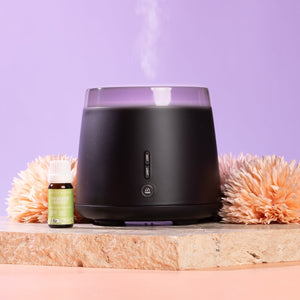10 Powerful Essential Oils for Pain Relief: Natural Remedies
Essential oils have long been used for their therapeutic properties, offering a natural approach to health and well-being. Did you know that essential oils for pain relief have become increasingly popular? From soothing sore muscles to potentially easing chronic pain conditions, these oils have captured the attention of both traditional medicine practitioners and individuals seeking alternative pain management solutions.
With so many varieties and applications of essential oils for pain, knowing where to begin can be overwhelming. This post will explore the benefits of various oils, how they work, and practical ways to incorporate them into your pain management strategy.
Table Of Contents:
- How Essential Oils Work for Pain
- 13 Essential Oils to Soothe Pain and Inflammation
- Using Essential Oils Safely
- FAQs about essential oils for pain
- Conclusion
How Essential Oils Work for Pain
Essential oils are highly concentrated extracts derived from the roots, stems, flowers, and leaves of plants. They contain a potent blend of natural compounds that can have various effects on the body.
For pain relief, these effects may come from their:
- Anti-Inflammatory Properties: Inflammation is a common contributor to pain. Certain essential oils possess anti-inflammatory properties that help reduce swelling and pain.
- Analgesic Effects: Some essential oils, such as wintergreen, contain natural pain-relieving compounds like methyl salicylate, which works similarly to aspirin.
- Muscle Relaxant Effects: Certain oils, like lavender essential oil, help to relax muscle tension, easing pain related to spasms and stiffness.
- Aromatherapy Benefits: Essential oils can also have powerful effects on the mind and mood. By impacting the brain's emotional centers, they may help reduce the perception of pain and promote relaxation.
It's crucial to note that while essential oils show promise for alleviating pain, more extensive research is needed to understand their efficacy fully. As with any health regimen, discuss with your doctor before incorporating them into your pain management plan, especially if you have existing medical conditions, allergies, or are pregnant or breastfeeding.
13 Essential Oils to Soothe Pain and Inflammation
There’s no magic “best” oil when it comes to using essential oils for pain relief - each has its own set of potential benefits.
| Essential Oil | Potential Benefits | How to Use It |
|---|---|---|
| Lavender |
Widely recognized for its calming and relaxing properties, lavender essential oil may help reduce pain in children after surgery. A 2012 study suggests that those who inhaled lavender after tonsillectomies used less pain medication. This multi-purpose oil may also provide pain relief comparable to that of tramadol when diluted and applied topically, as suggested by a 2015 study, as well as being beneficial for easing migraines. |
Add to diffuser, massage diluted into the skin, or add to a warm bath |
| Peppermint |
Known for its cooling sensation when applied to the skin, peppermint oil is often found in over-the-counter pain-relief ointments. Studies show peppermint oil is effective for relieving muscle aches, headaches, and even indigestion. A 2019 study suggests its effectiveness for relieving difficult swallowing and non-cardiac chest pain, while a 2015 study focused on its application for migraine pain. |
Add to a diffuser, apply diluted to temples, chest, or aching muscles, or use as a steam inhalation. |
| Eucalyptus |
Provides a cooling and anti-inflammatory effect similar to peppermint, eucalyptus oil is a common ingredient in over-the-counter creams like Icy Hot. A 2021 study suggests eucalyptus oil can significantly reduce pain and inflammation. |
Dilute and apply topically to chest or aching muscles, or use in a diffuser for respiratory relief. |
| Rosemary |
Rosemary oil shows promise in pain management, particularly in combination with traditional analgesic drugs, as highlighted in a 2015 study on mice. An earlier 2007 study suggests it may offer relief for those dealing with shoulder pain. |
Massage diluted into affected areas or add to a warm compress. |
| Chamomile |
Well-regarded for its soothing and relaxing properties, chamomile oil may be beneficial in reducing the need for pain meds for individuals with osteoarthritis, according to one 2015 study. Chamomile oil is great for relieving muscle tension and headaches. Research also suggests it could offer relief for those experiencing the symptoms of Carpal Tunnel Syndrome, with a 2017 study showing symptom improvement in individuals after topical application over four weeks. |
Diffuse, use diluted in massage, or add to a warm bath. |
| Clary Sage |
Often used for menstrual cramps and other types of pain, a small 2012 study focused on women who applied a clary sage oil blend during their menstrual cycle, showing notable pain reduction compared to the control group. |
Diffuse or massage diluted oil onto the lower abdomen. |
| Clove | Traditionally used to help soothe toothache pain, clove oil possesses pain-relieving and anesthetic properties, which is highlighted in an older 2006 study. | Dilute and apply topically, using with caution. (Clove oil is extremely potent and must be diluted appropriately). |
| Lemongrass |
Recognized for its anti-inflammatory properties and effectiveness at soothing sore muscles, lemongrass oil may reduce pain related to rheumatoid arthritis. Research backs up these benefits - a 2017 study on people with rheumatoid arthritis showed those using topical lemongrass had a decrease in their pain levels of around 30% on average over a month. Additional research from 2011 shows that native Australian Lemongrass has pain relieving compounds, including eugenol, similar to what's in aspirin, which makes it effective at soothing headaches and migraines. |
Dilute and massage onto sore muscles or affected areas or use in a diffuser for pain relief related to headaches. |
| Frankincense |
Highly valued for its potent anti-inflammatory effects, frankincense oil is traditionally used for various pain conditions. These long-standing medicinal applications are also reflected in more recent research; a 2011 review highlights these anti-inflammatory and pain-relieving benefits, while a 2014 animal study showed that it was potentially beneficial in treating arthritis. However, further research on humans is still needed to fully establish its effectiveness. |
Dilute and apply topically to affected areas or diffuse. |
| Rose |
Rose oil may help ease pain from period cramps, particularly when combined with other forms of pain relief. It can also offer relief when paired with other traditional treatment methods for kidney stones, with benefits being suggested by research done in 2013. |
Dilute and apply topically or diffuse to create a relaxing environment. |
| Bergamot |
Research suggests bergamot oil may be useful in tackling neuropathic pain - the kind that often resists even prescription pain meds. A 2015 study highlights its potential to offer relief for those battling this type of chronic pain. |
Apply diluted oil to areas of neuropathic pain. |
| Wintergreen |
Used as a natural pain reliever, wintergreen oil is a key ingredient in various over-the-counter creams and ointments thanks to its cooling, tingling sensation. Studies in 2014 suggest it may be an effective natural alternative for easing pain, but more research is needed. |
Dilute thoroughly in a carrier oil and use for topical application (use with caution; wintergreen oil can cause skin irritation.) |
Keep in mind that this is just a sampling, and many other pure essential oils, as well as oil blends, show promise for pain relief. Before incorporating essential oils into your life, research and choose ones that best align with your specific needs and sensitivities. For example, blends combining multiple essential oils are increasingly popular, especially when tackling pain conditions like menstrual pain or even terminal illnesses, as a 2012 study, another in 2013, and even one from 2008 have all demonstrated.
Using Essential Oils Safely
Because essential oils are extremely potent and concentrated, it's crucial to practice safety when using them. Direct contact with the skin can often lead to skin issues. They can even trigger unwanted effects if misused.
Always Dilute Essential Oils
Undiluted essential oils should never be directly applied to the skin, as doing so can cause severe irritation or even burns. Before applying, always dilute with a suitable carrier oil.
Carrier oils dilute essential oils, ensuring a gentle and safer application to the skin. They also help with spreading them over a larger area. Many natural carrier oils have additional benefits of their own. Some of the best ones to try for dilution include:
- Coconut Oil: Solid at room temperature, it softens with contact and is extremely moisturizing. Plus, it can also soothe pain.
- Sweet Almond Oil: Lightweight, gentle on most skin, absorbs readily, with moisturizing benefits.
- Jojoba Oil: Closely matches skin's natural sebum and great for balancing sebum production.
- Avocado Oil: A richer choice for dryer skin and packed with vitamins, anti-oxidants, and healthy fatty acids.
- Grapeseed Oil: Suitable for sensitive skin, good absorption properties, and generally doesn't leave skin feeling greasy.
Perform a Skin Patch Test
New to essential oils? Even if you're using a carrier oil, do a skin patch test before slathering up: This helps ensure your skin doesn't have a bad reaction. Dilute your chosen essential oil with a carrier oil and apply a small dab to your inner forearm to test.
General Guidelines for Safe Usage
For maximum safety, remember:
- Start Low: Use just a couple of drops to begin with and increase gradually as needed.
- Store Safely: To make them last longer, keep essential oils in dark glass containers in a cool spot out of direct sunlight.
- Pregnancy or Nursing: If you're expecting or nursing, Lively Living Pregnancy + Calm Oil is popular. Though consult with a qualified health care professional for specific advice on oil usage.
- Medical conditions: The same idea applies if you have pre-existing conditions. Getting your doctor’s advice beforehand ensures that the oil you’re using doesn’t conflict with existing medical treatments.
- Children: Always use extra caution when using essential oils for babies and kids and opt for mild blends formulated specifically for their use. We suggest to not use essential oils in a diffuser in a childs room before 3 months of age, though diffusing palin tap water has benefits and diffusing in the general livlng area is fine.
While using essential oils for pain has numerous benefits, knowing your sensitivities and the specifics of the oils you use is crucial. You should never take essential oils orally unless under the guideance of a medical practioner, apart from the odd drop in water etc Following these guidelines helps maximize their benefit while reducing the risk of reactions.
FAQs about essential oils for pain
What is the strongest essential oil for pain?
There is no single “strongest” essential oil, as the effectiveness varies based on the type of pain. However, oils such as kunzea, wintergreen, clove, peppermint, and eucalyptus are generally recognized for their powerful pain-relieving properties but should always be used diluted with caution.
What oil is good for inflammation and pain?
Many essential oils possess anti-inflammatory properties, making them good choices for pain and inflammation. Chamomile, lavender, kunzea, frankincense, and rosemary are frequently cited for easing pain from inflammation. Blends containing clary sage have also proven effective at targeting specific types of inflammatory pain, like menstrual cramping.
What essential oils are good for joint pain and inflammation?
When dealing with inflammation and pain in your joints, several oils show promise: Consider trying Kunzea oil or lemongrass oil, as both have strong anti-inflammatory properties and may aid in arthritis pain management. Rosemary oil is another good choice thanks to its combined ability to ease pain and target inflammation. And remember chamomile - studies have linked this calming oil to easing osteoarthritis symptoms.
What essential oil is like ibuprofen?
Wintergreen oil is often compared to ibuprofen. Its main component, methyl salicylate, is very similar in how it works to aspirin, which belongs to the same class of drugs as ibuprofen. The anti-inflammatory and pain-relieving actions of both are almost identical. Just be sure to dilute and test carefully for sensitivity, as, with ibuprofen, allergic reactions are always possible.
Conclusion
Incorporating essential oils into your pain relief toolbox can be a valuable and empowering step in your wellness journey. From potent singles like kunzea to the relaxing scents of lavender, exploring these gifts of nature is worth it. It's crucial to be mindful of proper safety practices like skin patch testing and to know your sensitivities before trying a new oil in full, as some individuals experience allergies to specific oils, especially the minty ones. Essential oils are concentrated, potent substances and have to be respected to enjoy their potential benefits without risking adverse effects.
Lively Living is Australias leading supplier of quality essential oils, diffusers and familywellness products. Estabvlished on the Gold Coast since 2012. Feel free to call 0412 521118 or contact the office by email info@livelyliving.com.au























